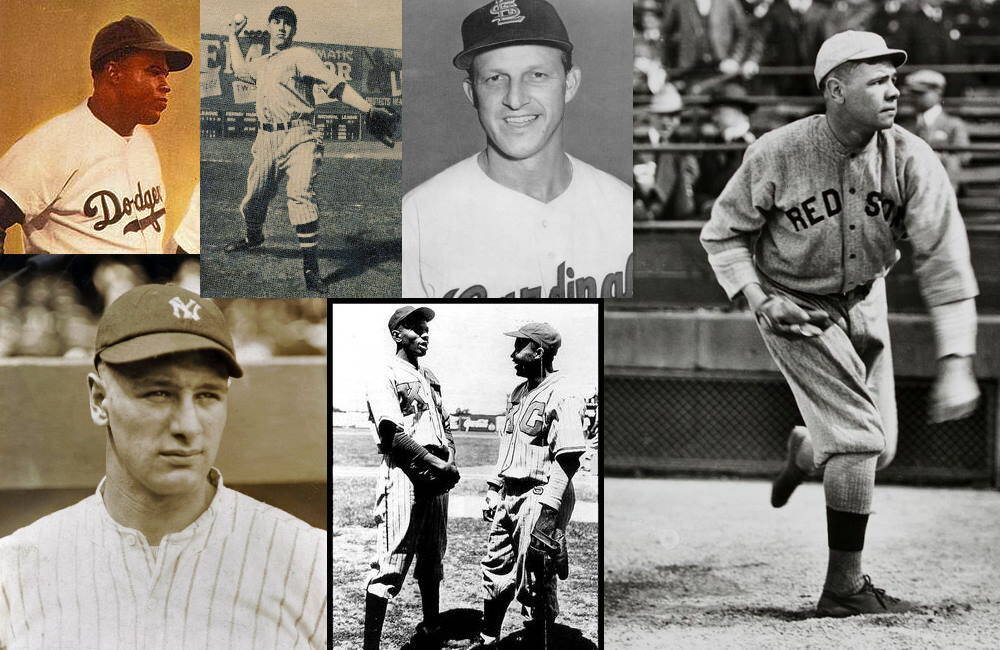Jackie Robinson is a revered figure in baseball, and for good reason. In addition to becoming the first black player in baseball history, he was an extraordinary player. Robinson had a .311 lifetime batting average, scored 947 runs, stole 197 bases, earned Rookie of the Year honors in 1947 and became the MVP in 1949.
He also went to six All-Star games in his Major League Career, all of it with the Brooklyn Dodgers. But there’s another way Robinson is associated with All-Stars – his “Jackie Robinson All-Stars” barnstorming team that toured the country in the late 1940 and early 1950s.
Robinson, who broke the color barrier in baseball in 1947, becoming the first black MLB player, created the barnstorming team to showcase the talent of Negro League players.
Jackie Robinson Early Life & MLB Career
Barnstorming a Big Part of Early Baseball
The Jackie Robinson All-Stars Tours was one of many tours through the decades that starred MLB players. They gave baseball fans a chance to see their heroes up close – often dozens of them at one time.
The first known tour happened all the way back in 1860, according to the MLB Hall of Fame. The Brooklyn Excelsior, an amateur team, played games around New York. By the 1880s, barnstorming happened every year. By bringing the game to places where fans might not otherwise see a game, the sport managed to gain in popularity.
By the 1920s, huge stars such as Babe Ruth played on barnstorming teams to both raise the popularity of the game and make money. Baseball team owners had threatened them, seeing the players as assets who should only display their talent in regular games attended by paying fans. But in 1922, a rule against barnstorming was removed.
How Does Baseball Rank in Popularity?
The Barnstorming Golden Age From 1920s to 1940s
The removal of the rule opened the door for barnstorming teams. One of the most famous happened in the 1920s, featuring Ruth and teammate Lou Gehrig. The two played with other stars divided into two teams, the Bustin’ Babes and Larrupin’ Lous. Fans across the country got a chance to the stars up close.
Future Hall of Famers such as Dizzy Dean, Bob Feller and Satchel Paige all hit the barnstorming circuit. There were teams featuring women (the Bloomer Girls), bearded men (the House of David) and multi-ethnic teams (All Nations).
And in the 1940s, one of the last and most famous was Jackie Robinson’s All-Stars.
What Made Bob Feller So Great?
Jackie Takes Tour On The Road
The first of the Jackie Robinson All All-Stars teams took to the road in 1946, while Robinson was playing for the minor league Montreal Royals. Robinson had joined the Royals after playing for the Indianapolis Clowns in the Negro Leagues.
The tour started in Harrisburg, Penn., before moving on to sites in the Midwest and then California, where Robinson had grown up. The team consisted of Negro League stars. According to Baseball History Today, they included Artie Wilson of the Birmingham Black Barons, John Scott of the Kansas City Monarchs. Ernie Smith of the Boston Blues in the U.S. Baseball League, and Bill “Wee Willie” Pope of the Pittsburgh Crawfords.
The barnstorming tours continued until 1953. Over the years, other black players got the chance to play with the team, including future Chicago Cubs star Ernie Banks. In those early years, the tour would go up against the Bob Feller and Satchel Paige tour, which pitted a white team against a black team. Robinson’s teams had both black and white players, according to PBS, which also noted that in some places, such as Comiskey Park in Chicago, Robinson’s All-Stars were the first racially integrated team to play in the stadium.
In some ways, Jackie Robinson’s All-Stars set the stage for Robinson to start playing with white players in Brooklyn the following season.
However, barnstorming began to phase out as TV brought the game into people’s homes wherever they lived. Also, as players’ salaries increased, they no longer needed the extra pay that barnstorming provided. And so, an early feature of the game faded away by the middle of the 20th century.


Leave A Comment